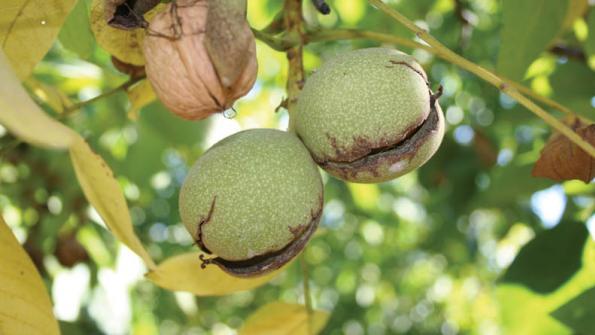
Effective in-season control of Botryosphaeria in walnut orchards starts with a May spray
Bot fungi infect the nut, move into the peduncle (the stem of the nut) and then invade the spurs, killing next year’s buds. Bot fungi can enter through wounds such as leaf scars, bud scars, and peduncle scars, pruning wounds, blighted fruit and scale infested wounds.

If Botryosphaeria canker and blight is present in your walnut orchard, the latest University of California research shows that the most effective time to start your in-season management of this fungal disease, which kills the next year’s buds, is mid-May.
In the March, 2015, issue of the Sacramento Valley Regional Walnut Newsletter, Janine Hasey, UC Cooperative Extension farm advisor for Sutter,Yuba and Colusa Counties, Bob Van Steenwyk, research entomologist at UC Berkeley, and plant pathologist Themis Michailides, UC Kearney Research and Extension Center in Parlier, Calif., describe the causes and characteristics of this disease, known simply as Bot. Also, they report results of a study last year at various locations in the Sacramento Valley testing effectiveness of different fungicide treatments in controlling it.
Bot fungi infect the nut, move into the peduncle (the stem of the nut) and then invade the spurs, killing next year’s buds. Bot fungi can enter through wounds such as leaf scars, bud scars, and peduncle scars, pruning wounds, blighted fruit and scale infested wounds.
Although Bot can infect immature nuts, one symptom of the disease – blighted fruit – isn’t noticeable until the nuts mature in August and September. During the season, brown-blighted shoots aren’t seen under dry weather conditions, unless sprinkler water is hitting foliage or some other water source is spreading the disease. Blighted spurs (twig blight) are common in fall, winter and early spring.
To determine how long pruning wounds remain susceptible to Bot infection, Michailides inoculated wounds at several intervals up to 28 days in Chandler, Vina, and Tulare varieties. The researchers were surprised to find that even four weeks after pruning, pruning wounds were still susceptible to Bot infections, and canker development was the same as in the earlier inoculations. “This means there should be at least one month between pruning and a rain event to avoid infection,” they write.
Most of the treatments applied in mid-May, mid-June, and mid-July in the 2014 trial, were effective in reducing Bot infections, cankered spurs and black or brown kernels. The researchers found no clear benefit to adding a postharvest spray to the May+June+July treatment in the Colusa trial or the bloom or postharvest spray in the Sutter Chandler trial.
In the Howard orchard, sprays at bloom only, postharvest only, or at bloom plus postharvest did not reduce disease significantly from the check. Based on these results, the researchers don’t recommend bloom or postharvest sprays alone. The fungicides applied last year in Butte County also reduced blighted spurs and Bot infected buds collected in February of this year.
Details of the Bot fungicide trial are available online at http://cetehama.ucanr.edu/Newsletters
Because of the large size of walnut trees and fruitwood distribution, the researchers recommend both cultural and chemical controls. They include:
Avoiding sprinkler irrigation that wets the canopy, spreading the disease.
Controlling scale insects which can increase Bot infection and canker development.
Pruning dead branches back to healthy green wood during the summer or immediately following harvest, allowing at least one month before heavy rains can spread inoculum to susceptible pruning cuts.
Removing infected wood from the orchard floor to reduce the inoculum load. This applies mainly to orchards with light-to-medium Bot infection.
Applying a fungicide spray mid-May, mid-June, and mid-July to reduce Bot infections.
About the Author(s)
You May Also Like



